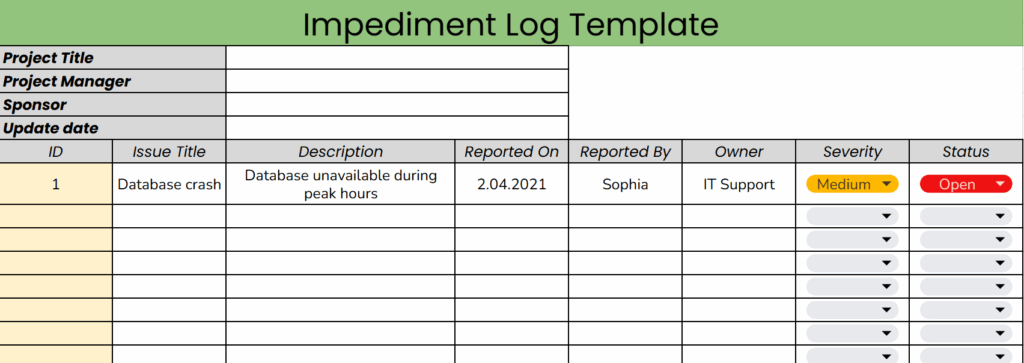1. Introduction
Definition of an Impediment Log
In Agile and Scrum environments, teams strive to deliver high-value increments with speed and flexibility. Yet, despite the best planning, impediments—anything that blocks or slows team progress—inevitably arise. This is where the impediment log comes into play.
An impediment log is a centralized, living document used to track, manage, and resolve blockers affecting team performance. It promotes visibility, accountability, and timely intervention. As a Project Manager, I’ve implemented this tool in numerous Agile projects to keep delivery smooth and teams focused.

Importance in Agile & Scrum
Agile thrives on transparency, collaboration, and continuous feedback. Therefore, a well-maintained impediment log supports all three. It allows for:
- Faster issue identification
- Efficient team collaboration
- Prioritization and escalation of blockers
This approach enables teams to maintain their velocity and improves sprint predictability.
How It Differs from a Risk Register or Issue Log
Although similar, each log has a distinct function:
- Risk Register: Proactively identifies potential future problems.
- Issue Log: Captures problems that have already occurred and need attention.
- Impediment Log: Focuses on present obstacles affecting sprint progress.
In short: Risk is about the future, issues are about the past, and impediments are about the now.
2. What is an Impediment?
Definition & Examples
An impediment is any obstacle that negatively impacts the team’s ability to deliver on their sprint goal. These can range from minor annoyances to full-on project halts.
Examples include:
- A team member’s unexpected leave
- Delayed approval from a stakeholder
- Inaccessible development environments
- Slow decision-making due to unclear roles
Types of Impediments: Blockers vs. Hindrances
Understanding the severity of impediments helps prioritize them appropriately.
- Blockers: These halt progress entirely. For example, a server outage during deployment.
- Hindrances: These slow down delivery but don’t stop it. For instance, lack of training on a new tool.
Internal vs. External Impediments
- Internal: Originates within the team (e.g., lack of skills, interpersonal conflicts).
- External: Caused by factors outside the team (e.g., third-party delays, client feedback bottlenecks).
By classifying impediments this way, you can assign the right resolution strategy and ownership.
3. The Role of the Impediment Log in Agile & Scrum

Purpose & Benefits
The main goal of the impediment log is to surface blockers early and track their resolution. Its benefits include:
- Enhanced team visibility
- Improved sprint delivery
- Support for proactive problem-solving
- Stronger stakeholder trust
Who Owns the Impediment Log?
The Scrum Master typically maintains the log. However, as a Project Manager, I ensure alignment by facilitating collaboration between:
- Scrum Master (ensures process adherence)
- Product Owner (sets priorities)
- Team Members (report blockers)
How It Supports Continuous Improvement
A continuously updated impediment log acts as a knowledge base. Reviewing it during retrospectives reveals recurring issues, enabling teams to take preventative action and improve their processes over time.
4. Key Components of an Impediment Log
An effective impediment log includes several standard fields that facilitate structured tracking and resolution.
| Field | Purpose |
|---|---|
| Impediment Description | Clear, concise summary of the blocker |
| Date Logged | When the impediment was first noticed |
| Priority | Urgency and impact on the team |
| Owner | Person responsible for resolving it |
| Status | Whether it’s open, in progress, or resolved |
| Resolution Date | When the impediment was cleared |
| Impact | (Optional) Details on sprint/team disruption |
| Category | (Optional) Type of impediment (technical, organizational, procedural) |
| Root Cause | (Optional) Analysis of why it occurred |
Having a template ensures consistency and helps during sprint reviews and retrospectives.
5. How to Create & Maintain an Impediment Log
Step-by-Step Process
- Set up a template in your chosen tool (Jira, Trello, Excel, etc.)
- Encourage team members to report impediments during standups or through the Scrum Master.
- Log each impediment immediately.
- Assign ownership for resolution and set target dates.
- Update status daily and track until resolved.
- Analyze patterns during retrospectives.
Best Practices for Tracking & Updating
- Keep it simple and visible.
- Prioritize based on sprint goals.
- Revisit and discuss it regularly.
- Assign clear ownership and resolution timelines.
Tools for Managing Impediments
Depending on your team setup, you might use:
- Jira: Use custom issue types or labels.
- Trello: Create a dedicated board or lane for impediments.
- Excel/Google Sheets: Flexible, easy to share and customize.
- Miro/Mural: For visual collaboration during retrospectives.
6. Impediment Backlog vs. Impediment Log
Differences & Similarities
| Feature | Impediment Log | Impediment Backlog |
|---|---|---|
| Purpose | Track current blockers | Store anticipated or future blockers |
| Timeframe | Real-time | Long-term planning |
| Maintenance | Daily | Periodic |
| Responsibility | Scrum Master / Team | Scrum Master / Product Owner |
When to Use Each
- Use the impediment log daily during sprints.
- Use the impediment backlog during planning or retrospectives to anticipate future risks.
7. How to Resolve Impediments Effectively

The Escalation Process
If a blocker cannot be resolved at the team level:
- Escalate to the Scrum Master.
- Loop in Product Owner or Project Manager.
- Communicate with external stakeholders as needed.
- Update log with resolution status.
Collaborative Problem-Solving Techniques
- Fishbone Diagram: For root cause analysis.
- 5 Whys: To dig deeper into recurring issues.
- SWOT Analysis: For strategic decisions around larger impediments.
Common Pitfalls & How to Avoid Them
| Pitfall | Solution |
|---|---|
| Ignoring low-priority issues | Review all impediments during retrospectives |
| Lack of ownership | Assign a clear responsible party for each item |
| Delayed escalation | Define thresholds for escalation in sprint rules |
8. Impediment Log in Scrum Events
- Daily Standups : Each team member reports what’s blocking them. New impediments are logged and prioritized.
- Sprint Retrospectives : Use the log to identify recurring blockers, discuss root causes, and brainstorm preventive actions.
- Sprint Planning : Review past impediments to refine user stories, estimate better, and set realistic sprint goals.
9. Advanced Tips for Mastering Impediment Management
Proactive vs. Reactive Approaches
Proactive:
- Conduct pre-sprint risk mapping
- Maintain an impediment backlog
- Encourage psychological safety so team members speak up early
Reactive:
- Use a consistent log and escalation process
- Document every resolution for future reference
Using Metrics to Track Impediment Resolution
Track metrics such as:
- Time to resolve
- Number of impediments per sprint
- Recurrence rate
Visual dashboards in tools like Jira can help here.
Building a Culture of Transparency & Continuous Improvement
Encourage open communication. Celebrate resolved impediments in retrospectives. This creates a team culture where blockers are seen as opportunities for growth, not failures.
10. Conclusion
Recap of Key Takeaways
- The impediment log is a foundational Agile tool for tracking blockers.
- It supports sprint success, fosters collaboration, and promotes continuous improvement.
- By using clear templates, assigning ownership, and tracking metrics, teams can resolve blockers efficiently.
- As a Project Manager, I’ve seen firsthand how this simple tool transforms team dynamics and delivery success.
Final Thoughts on Continuous Improvement
Managing impediments effectively is not just a task—it’s a mindset. It requires transparency, discipline, and a focus on outcomes. Implementing a structured impediment log will empower your Agile team to stay on track and continuously improve.



